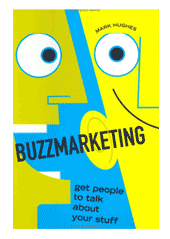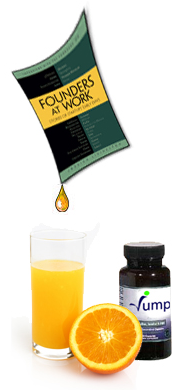 If you like Seth Godin’s philosophy and the main message of Purple Cow you’ll dig Buzzmarketing. In a world of advertising in which we are deluged with thousands of sound bites and ads competing for our attention, the most successful marketing campaigns are the ones that achieve buzzworthiness and propel themselves beyond the initial transmission via word-of-mouth. Doug Hughes says the key to marketing is giving people a message that’s worthy of talking about. And I couldn’t agree more. Anybody who is able to convince an entire town in Oregon to rename itself to Half.com and literally put a company on the map gets my ear for a day. Here are the key points and takeaways from reading this book.
If you like Seth Godin’s philosophy and the main message of Purple Cow you’ll dig Buzzmarketing. In a world of advertising in which we are deluged with thousands of sound bites and ads competing for our attention, the most successful marketing campaigns are the ones that achieve buzzworthiness and propel themselves beyond the initial transmission via word-of-mouth. Doug Hughes says the key to marketing is giving people a message that’s worthy of talking about. And I couldn’t agree more. Anybody who is able to convince an entire town in Oregon to rename itself to Half.com and literally put a company on the map gets my ear for a day. Here are the key points and takeaways from reading this book.
The six buttons
Hughes believes there are six traits of buzzworthy topics. If you find a way to incorporate a couple of these qualities in your messaging, you stand a good chance of having other people passing it along. By nature we like to talk about:
the Taboo
the unusual
the outrageous
the hilarious
the remarkable
secrets
Basically we like to be interesting. Couch your messaging in way that lends itself to 2-3 of these qualities and it becomes “conversation currency.” Hughes explores a couple marketing success stories to substantiate this theory. For instance Miller Lite was hugely trailing its competitor Budweiser until their marketers found their sweet spot in positioning the brand. From conducting ol’ fashioned face to face market research studies in bars they learned that most bar patrons weren’t truly concerned with calories, they instead gravitated towards a specific light beer because it made them less bloated so they could stay longer at the bar. Once they discovered this hot button, Miller crafted its messaging around this aspect and then delivered an ingenious marketing campaign around the idea of “tastes great, less filling.” It became such a popular refrain that it was literally sung by fans in stadiums everywhere and Miller became the 2nd most popular brand of beer in the world.
Hughes recounts the story of a chiropractor in New York that built a multi-million dollar practice by working on homeless people for free. That’s impossible you say? He recognized the value of word-of-mouth advertising and what occurs when you truly improve the quality of life for a few people requiring only the payment of lip service. By deferring cash payment for the first year he was able to build a massive grass roots awareness of his practice and book as many as 10x the number of clients his competitors had. He established offices that allowed him to treat people on a massive scale and eventually gobbled up competitors that defected from their own practice to join his.
Hughes dissects the success of the TV show American Idol and how it was able to achieve impossible growth in viewership season after season in spite of the fact that every network but one had shot it down initially. Citing a Bonnie Rait song (which I despise btw), he pounds home the point that as marketers our job is simple: “let’s give ’em something to talk about.” His analysis of the American Idol show, the community that developed around it and the countless water cooler conversations it has spawned reminded me a lot of the TV show “Friends” that was popular ten years ago when I was in college. There were social groups of people in every dorm that would spontaneously gather around the TV in the common areas to watch this show and at every commercial they would dive into lively conversation around the characters of that show. Complete strangers were united by their connection to the characters in this show. It was like meeting someone and having a mutual friend. What the makers of that show (and every other successful TV show like it) realized is that in the end people just want to connect with others. The show The Office on TV now is the current equivalent providing office workers with this shared common experience that reaches them on an emotional level. Marketers that continue with traditional techniques of blasting loud messages will eventually find that their target constituency has long ago donned noise-canceling headphones and are happily chatting away with each other via skype about the next product that shares one of the six traits of buzzworthiness.
 A major takeaway for me here was his point about “empowered interactivity” – American Idol single-handedly did for SMS text messaging what a failed $120-million dollar ad campaign around the mLife product could not do for AT&T. Give the people that use your stuff a way to show off their own intelligence via ratings, reviews, case studies, testimonials, whatever and they will become much more invested in your product. One-third of the people that voted on American Idol had never texted before the show- it was a compelling enough use case to drive 7 million people to adopt SMS. And all just so they could have a say in who won a contest on TV. The point is: do what Kathy Sierra preaches and recognize that it’s not about you, it’s about helping your users kick ass.
A major takeaway for me here was his point about “empowered interactivity” – American Idol single-handedly did for SMS text messaging what a failed $120-million dollar ad campaign around the mLife product could not do for AT&T. Give the people that use your stuff a way to show off their own intelligence via ratings, reviews, case studies, testimonials, whatever and they will become much more invested in your product. One-third of the people that voted on American Idol had never texted before the show- it was a compelling enough use case to drive 7 million people to adopt SMS. And all just so they could have a say in who won a contest on TV. The point is: do what Kathy Sierra preaches and recognize that it’s not about you, it’s about helping your users kick ass.
The story of the Apple 1984 Superbowl commercial that catapulted the Macintosh to mainstream popularity could probably be a book on its own. Not only did that single ad (which again was initially killed by the company’s Board) resuscitate a struggling company, it arguably created the Superbowl Sunday ad pageant that’s become a yearly tradition for marketers to show off the best-in-show of advertising.
Capture Media
It’s no secret that the more newsworthy you become, the less you have to push things uphill via paid marketing initiatives and the more you get to enjoy the downhill toboggan ride of the press writing about you. Hughes believes there are five hot buttons for reporters, and they are stories that:
have a David and Goliath theme
are unusual or outrageous
incite controversy
include a celebrity
play on an already-hot topic in the media
So this isn’t an Einstein, ground-breaking discovery here but he retells the story of Clearplay DVD and how they drove a successful marketing campaign that consisted entirely of legal fees. This company was one of a dozen that produced a “vchip-like” technology for DVD’s that allowed parents to selectively screen out unsuitable content for their children based on thresholds defined by Clearplay. While every competitor yielded under impending lawsuits from the major Hollywood directors and studios, the Clearplay CEO saw the David & Goliath controversial showdown over the home remote and went for the jugular. The press ate up the story and people began to rally around the call of “who controls your remote, Hollywood directors or you?” In the face of copyright lawsuits from heavyweights like Spielberg who said “you’re damaging the artistic integrity of my work by altering it,” Clearplay struck a nerve with parents, kept to its story and ultimately triumphed winning major deals with studios and distributors. Hughes relates a nearly identical David & Goliath story around Ben & Jerry’s ice cream.
My only problem with this reasoning is that, “history is written by the victors.” No arguments that taking a bold stand is going to make you newsworthy, but it also makes you a big frickin’ target for the opposition and sometimes Goliath wins in those situations. I’m reminded of the ReplayTV vs. Tivo battle and how sometimes riding in the slipstream of a competitor that chooses to lash out and absorb the brunt of the opponent’s attacks can be a more effective survival strategy. You don’t always have to outrun the bear…
 The takeaway here for JumpBox is that we need an adversary. And not an adversary as in a competitor producing virtual appliances, but adversary in terms of an iconic Goliath that our users can commiserate over and feel unified against. We had tossed around a clever idea for an ad campaign awhile back involving a “Lumberg figure” and how JumpBox was the equivalent of sawing your cube in half and gutting a fish on your desk. Sales are made when you connect with people emotionally and not from logical conclusions drawn from statistics and research. Even if you have something wildly useful, failing to connect with your market on an emotional level means you only capture people making head decisions and not gut decisions.
The takeaway here for JumpBox is that we need an adversary. And not an adversary as in a competitor producing virtual appliances, but adversary in terms of an iconic Goliath that our users can commiserate over and feel unified against. We had tossed around a clever idea for an ad campaign awhile back involving a “Lumberg figure” and how JumpBox was the equivalent of sawing your cube in half and gutting a fish on your desk. Sales are made when you connect with people emotionally and not from logical conclusions drawn from statistics and research. Even if you have something wildly useful, failing to connect with your market on an emotional level means you only capture people making head decisions and not gut decisions.
Attention
The fact you’re still reading at this point given the length of this post is laudable, so thanks for your attention. The point of this chapter is very simply: if you’re average you’re invisible. Hughes says we can do four things to better grab people’s attention:
follow a balanced multimedia diet for how we advertise
find clutter-free media – the spaces where there is nothing else competing for attention
take off the shine and reveal the underbelly of your organization – essentially the advice from the Wired cover story Get Naked and Rule the World
product placed inextricably in the content itself- think songs like “pass the courvoisier“
There has never been as fierce a competition for people’s mental cycles as there is now. And we can expect the competition for attention to get more desperate over time. As Hughes says, “without attention nothing happens” (it’s the whole “tree falls in the woods” phenomenon). The pattern that manifests again and again in companies as they grow is that they start out with a bold approach that gets them famous and then they become complacent and reserved gravitating towards less-risky decisions- it’s essentially the Innovator’s Dilemma applied to marketing. Messaging evolves to a pasteurized, mr-potato-head-like jumble of blandness quilted together by committee. Viewers mistrust it, and more likely, stop caring altogether (kind of how we feel about Microsoft at this point).
Supposedly in relationship counseling they say hatred is easier to resolve than apathy because at least the partner still cares and has feelings to work with. When it’s pure indifference and there’s an absence of feeling it’s impossible to fix. Same is true for a brand- it’s better to be loved or hated but when people just don’t care, then you’re hosed. Hughes delves into Britney Spears’ rise to stardom to see how her agent and publicist capitalized on attention to build her career. He recognized her talent when she was thirteen but held off on promoting her for two full years until he detected that the market was ripe for her debut. Mis-timing her launch would have almost certainly meant a fizzled career because of the scarcity of attention from the target demographic given the cycle of pop stars and that it was devoted away from poppy bands towards rock and hip hop. Obviously there was a lot more that contributed to her success than perfect timing, but launching when conditions were optimal as far as attention from the target market was a critical factor.
 Again, hindsight is always 20/20 but the takeaway here for me is that conditions now are primed for the AdSqueeze concept. Given the ADHD nature of people growing up, the fierce battle for attention and the existence of commercial-skipping technologies via DVR’s, something like AdSqueeze is sure to sprout up within the next year. And it will be a fad like Million Dollar Homepage that runs it’s course in six months, experiences a bunch of copycat competitors and then flames out. But not before somebody makes a mint on ad revenue reshapes the TV advertising landscape by offering a different model. I wish I had extra cycles and the ability to bankroll this project right now because someone will do it.
Again, hindsight is always 20/20 but the takeaway here for me is that conditions now are primed for the AdSqueeze concept. Given the ADHD nature of people growing up, the fierce battle for attention and the existence of commercial-skipping technologies via DVR’s, something like AdSqueeze is sure to sprout up within the next year. And it will be a fad like Million Dollar Homepage that runs it’s course in six months, experiences a bunch of copycat competitors and then flames out. But not before somebody makes a mint on ad revenue reshapes the TV advertising landscape by offering a different model. I wish I had extra cycles and the ability to bankroll this project right now because someone will do it.
Climb Buzz Everest
The point of this chapter is that big wins only come with big risks. Find the Mount Everest-sized challenge that can put your company on the map and then tackle it. Hughes did precisely this with his company Half.com and persuaded a town named Halfway in Oregon to actually change its name to Half.com. Other instances of companies that climbed Buzz Everest:
Pepsi goaded Coke drinkers to take the Pepsi Challenge after discovering from legitimate taste tests that people genuinely preferred Pepsi over Coke (the key here in this that the author neglects to mention is that Pepsi in small doses is preferable due to its sweetness – listen to a podcast from Malcom Gladwell for a discussion on this).
The revival of Tie Dye t-shirts (and consequently the lesser-known brand of die behind them, Rit Dye) is another story of a marketing comeback from a guy that chose to ditch a comfy position marketing a sure-thing product in order to take on the impossible and climb a Buzz Everest. Doc Searls talks about effective marketing as the art of starting a forest fire of buzz by creating sparks in the right places. The Tie Dye story is a classic example of how to start a blaze by a few well-placed sparks.
Discover Creativity
At this point it felt like Hughes had said most of what he wanted to say and was stretching for two more chapters to round out his six points. His advice regarding creativity is to:
dump the idea of marketing strategy and simply define the marketing problem succinctly
understand your consumers intimately
swing the bat often and not be afraid of failure – (ie. Babe Ruth struck out more than anyone)
create internal competition and pit marketing teams against one another
produce creative content, not ads
He urges companies to think about failure differently- treat them like fouls in a basketball game rather than one-strike-you’re-out mistakes. When your players finish the game with four fouls that’s when they’ve pushed the limit and played their hardest. Anyone who finishes with zero fouls isn’t getting scrappy enough and taking risks. He talks about the Ford Mustang and how their marketing team did a masterful job of creating mystery around the product via “ads that hyped future ads” leaving people a secret to be discovered. Ford connected with local DJ’s and gave them individual test drives of the Mustang and then ran ad spots with the radio stations in which the DJ’s had to write their own copy for the spots relating the experience of driving the car. The result was an authentic referral from a trusted personality instead of a regurgitated sound bite from a large corporation and a product that had individuality infused into it from day one. Likewise, the Mini Cooper automobile has amassed so much personality associated with its image that 75% of their owners name their cars and 60% mod them with custom enhancements/decorations to make them more unique and personalized. When the user is that invested in the product, you can be they are going to show their friends wallet pictures of their baby.
Police Your Product
The last chapter is devoted to the importance of discovering and handling negative buzz early. This too seemed like brain-dead-simple common sense but Hughes points out that massive buzz blunders have caused irreparable damage to big companies. Ten years ago, the fires didn’t spread nearly as quickly because the communication means available at the time weren’t as networked and multi-media. The Internet-related technologies like web, blog, email, IM, youtube, twitter, etc. have amplified the voice of the consumer and both broadened the audience and condensed the time frame for the transmission of buzz down to seconds. Look at how quickly the Jet Blue debacle got away from them in February. Hours after being stranded on the tarmac people were taking pictures of overflowing toilets in the airplanes from their camera phones and posting them to their blog.
Every citizen is now potentially a journalist. I learned this power first-hand through posting a negative experience on my blog after dealing with Sprint customer service. <- That blog entry has gotten thousands of visits appearing on the first page of google results for the search term "sprint customer service." As Hughes says, "23 complaints = 10,000 enemies” via the digital grapevine of communication that occurs from people posting and reading these painful stories when researching a product. Negative reviews on sites like Epinions, Yelp, Tripadvisor and Amazon cause severe material damage to companies and the smart ones have people trolling search engines to stay ontop of customer complaints made out in the blogosphere. You’re also seeing a rise of technologies like the Listening Post to monitor buzz and serve as the early warning radar so companies can detect and respond to potential PR disasters before they become catastrophic.
Hughes says of all the survey questions companies ask, there’s really only two that matter:
How did you hear about us?
Would you be willing to go out of your way to tell a friend about our product?
 This was a mild takeaway for me. The first tracks the effective sources of how people are finding you and your all important number: the word-of-mouth factor. The second gauges the buzzworthiness of your product and implicitly asks for a commitment from your users. We already do the first one and we’ll be implementing the second on JumpBox just as soon as I finish writing this.
This was a mild takeaway for me. The first tracks the effective sources of how people are finding you and your all important number: the word-of-mouth factor. The second gauges the buzzworthiness of your product and implicitly asks for a commitment from your users. We already do the first one and we’ll be implementing the second on JumpBox just as soon as I finish writing this.
Conclusion
If you’re into marketing, this book is worth a read. Of the handful of business books I’ve read recently, this one produced a respectable 3 1/2 takeaways and for me that factor is always the gauge of a valuable, thought-provoking read. There is one particular idea I got for a promotion which I need to run by our lawyers first. It’s so out there that I’m afraid it violates both SEC and gambling laws, but if not, you’ll be hearing about it soon enough as it will be coming second-hand to a water cooler near you.




 Spigit is an interesting site that functions almost like a “fantasy league for startup ideas.” We’re on their homepage now featured as the “launch of the day.” I’m using this opportunity to market test this idea we have for offering “on-site Software as a Service.” The thinking is basically this:
Spigit is an interesting site that functions almost like a “fantasy league for startup ideas.” We’re on their homepage now featured as the “launch of the day.” I’m using this opportunity to market test this idea we have for offering “on-site Software as a Service.” The thinking is basically this:
 How do you get hired for a job without experience?
How do you get hired for a job without experience? How do you gain experience without having a job?
How do you gain experience without having a job? These paradoxical problems are seemingly unsolvable at first glance because (like one of those weird
These paradoxical problems are seemingly unsolvable at first glance because (like one of those weird  Here’s another example: you know those cardboard boxes that require assembly? They arrive as a pancake and require that you expand them and close the flaps at one end to make the floor of the box. The flaps, however, all lay together in an impossible interlocking arrangement. If you’re like me you flounder with it for five minutes cursing the cardboard until you manage to wrangle it just close enough where you can cram one of the flaps underneath the other and then, eureka! it all falls together. At some point though, you just have to bend one of the flaps and make it work.
Here’s another example: you know those cardboard boxes that require assembly? They arrive as a pancake and require that you expand them and close the flaps at one end to make the floor of the box. The flaps, however, all lay together in an impossible interlocking arrangement. If you’re like me you flounder with it for five minutes cursing the cardboard until you manage to wrangle it just close enough where you can cram one of the flaps underneath the other and then, eureka! it all falls together. At some point though, you just have to bend one of the flaps and make it work. 
 A major takeaway for me here was his point about “empowered interactivity” – American Idol single-handedly did for SMS text messaging what a failed $120-million dollar ad campaign around the mLife product could not do for AT&T. Give the people that use your stuff a way to show off their own intelligence via ratings, reviews, case studies, testimonials, whatever and they will become much more invested in your product. One-third of the people that voted on American Idol had never texted before the show- it was a compelling enough use case to drive 7 million people to adopt SMS. And all just so they could have a say in who won a contest on TV. The point is: do what
A major takeaway for me here was his point about “empowered interactivity” – American Idol single-handedly did for SMS text messaging what a failed $120-million dollar ad campaign around the mLife product could not do for AT&T. Give the people that use your stuff a way to show off their own intelligence via ratings, reviews, case studies, testimonials, whatever and they will become much more invested in your product. One-third of the people that voted on American Idol had never texted before the show- it was a compelling enough use case to drive 7 million people to adopt SMS. And all just so they could have a say in who won a contest on TV. The point is: do what  This was a mild takeaway for me. The first tracks the effective sources of how people are finding you and your all important number: the word-of-mouth factor. The second gauges the buzzworthiness of your product and implicitly asks for a commitment from your users. We already do the first one and we’ll be implementing the second on JumpBox just as soon as I finish writing this.
This was a mild takeaway for me. The first tracks the effective sources of how people are finding you and your all important number: the word-of-mouth factor. The second gauges the buzzworthiness of your product and implicitly asks for a commitment from your users. We already do the first one and we’ll be implementing the second on JumpBox just as soon as I finish writing this. 







